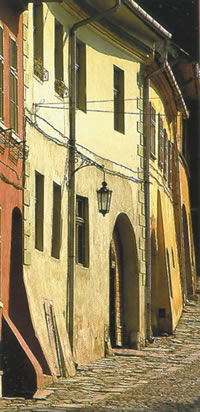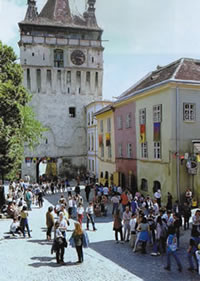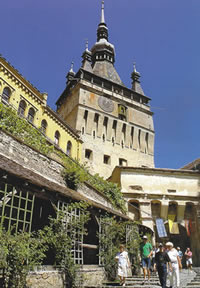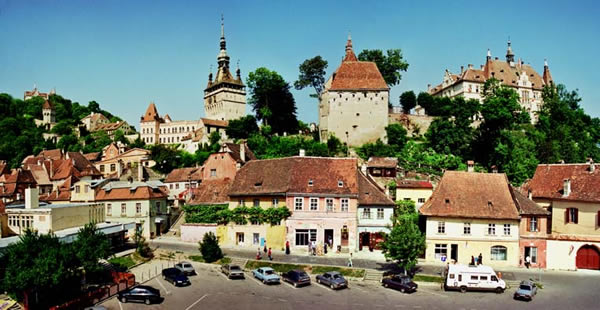
|
 |
Geographically,
Sighisoara
is located in the heart of Romania, at 24° 46' 40"
eastern longitude and 46' 12' 38" northern latitude,
in the middle basin of the Târnava Mare River.
This natural amphitheatre,
almost entirely covered by woods, has a mild-continental
climate. Its ancient civilization evidences go back to
the Stone Age. The late Bronze Age (1700-1300 B.C.) is
remarkable, it was the time when the "Sighisoara-Wietenberg"
archeological culture took shape. Later, in the Dacian
period, the valley of the Târnava Mare became an
important commercial road, controlled by a solid fort
built over the prehistoric settlement of the Wietenberg
Hill.
This citadel was destroyed
during the first years of the 2nd Christian century (106
A.C.), when Dacia became a Roman province. In order to
maintain the safety of the roads that crossed the area
on the left bank of the Târnava River, the Roman
army built a defense fort in the place known today as
"Podmoale". Although relatively short, the Roman
administration left behind an important romanised population,
whose evidence and settlements were discovered in the
archeological sites of "Dealul Viilor" and "Albesti-Valea
Sapartocului".
As ages went by, the Hungarian
tribes gradually settled in Transylvania and, at the beginning
of the 12th century, arrived in the valley of Târnava
Mare, that, for a short time, would be a part of the southern
border of the Arpadian kingdom. This seems to be the reason
why they built a small border fort on the superior plateau
of the Cetatii Hill. At the same time, the Hungarian King
Geza the 2nd invited the inhabitants of the German areas
to settle in Hungary and Transylvania, where, in exchange
of a large autonomy, they were to help with the defense
of the border and the prosperity of the kingdom. According
to the local custom and to the medieval chronicles, the
first Saxons settled in Sighisoara in 1191 or 1198.
|
 |
In
the first decades that followed their arrival, the small
settlement witnessed a quiet evolution, but the great
Tartar-Mongolian invasion of 1241 suddenly revealed the
resources that turned it into one of the "Seven Citadels"
("Sapte Cetati") of the medieval Transylvania.
And so, beginning with the second half of the 13th century,
Dealul Cetatii was surrounded by a solid wall that, at
the end of the Middle Ages, protected a small town with
over 160 houses and 13 public establishments. The fort
was strengthened and protected by 14 towers, among them
only 9 resisted in time, keeping to the present day the
name of the guilds they belonged to. The Clocktower, symbol
and pride of Sighisoara, catches the eye. Built in the
13th - 14th century and initially named "The Great
Tower of the Gate" ("Turnul cel Mare al Portii"),
it had at the beginning of the 17th century a rudimentary
clock, transformed in 1648 in one that "had never
existed before in Transylvania". And in this way,
apart from the fact that the new mechanism was able to
show the minutes and to strike the quarters of an hour,
it was also capable of setting in motion several wooden
figures, impersonating the pagan gods that represented
the days of the week: Diana, Mars, Mercury, Jupiter, Venus,
Saturn and the Sun. |
 |
The
leading military character of the town is obvious even
from the beginning, so obvious that it can be found in
all the names that the town has had even from the first
documentary references: Castrum Sex (1280), Schä2burg
(1298), Segesvar (1301), Sighisoara (1431). First mentioned
as a town in 1367, "civitas de Seguswar" shortly
became a blossoming place for the guilds, and in the following
century its reputation grew that much that in 1431 the
Walah prince Vlad Dracu settled in the "watch nest
from Sighisoara". It was here where Vlad Dracu led
the defense of the south border of Transylvania since
1436, issued his own coin and prepared to take over the
rule of his home country. Traditionally, it is said that
this remarkable character lived in the "Vlad Dracu
House" and that this house was the birthplace of
Vlad the Impaler. |
 |
In
1918, once Transylvania joined the Romanian kingdom, the
Saxon population was integrated in the new state and the
number, the political and economic role of the Romanians
in the town grew considerably. After 1950 Sighisoara developed
as an industrial center, but lost the status of administrative
capital, becoming district capital and then "only"
the second town in the Mures County.
The revolution of 1989 brought
along a new beginning for this town, Sighisoara being
among the first cities in Romania that declared themselves
"free of communism" even before president Ceausescu
fled. But coming back to normality was not, an is not
an easy thing. Still, after a few years of searching,
the local economy and the social life begin to shape up,
being characterized by stability and durability. Especially
after 2000, the municipality emphasized the importance
of alternatives as far as lohn work is concerned, encouraging
especially the segment of services and cultural tourism.
An excellent proof in this respect is the fact that Sighisoara
benefited from the debates concerning the "Dracula
Park" project, debates that turned into an impressive
advertising capital, all these determining a significant
increase in number as far as tourists are concerned, and,
consequently, an unprecedented development of hotel services.
The massive investments
in infrastructure, in social and community services, in
educational and sport utilities - Sighisoara benefiting
from one of the most modern sport hall from Romania -
marks the steps towards Sighisoara's integration in the
large European community, emphasized by the fact that
the town was granted "The Honour Plaquette of the
European Council". At the same time, the transformation
of the CFR railway station in a Eurostation and the intersection
in Sighisoara of the IV Paneuropean railroad with the
Brasov-Bors highway proves - as a medieval chronicle anticipated
in the 16th century - that "the jewel of Sighisoara
will always shine and that its glory will be eternal".
|
 |
|
|
|

